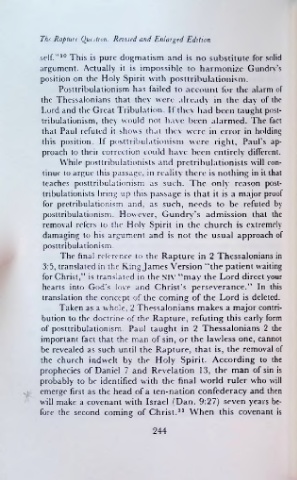Page 235 - The Rapture Question by John F. Walvoord
P. 235
The Rapture Question: Revised and Enlarged Edition
self.”10 This is pure dogmatism and is no substitute for solid
argument. Actually it is impossible to harmonize Gundry's
position on the Holy Spirit with posttribulationism.
Posttribulationism has failed to account for the alarm of
the Thessalonians that they were already in the day of the
Lord and the Great Tribulation. If they had been taught post
tribulationism, they would not have been alarmed. The fact
that Paul refuted it shows that they were in error in holding
this position. If posttribulationism were right, Paul’s ap
proach to their correction could have been entirely different.
While posttribulationists and pretribulationists will con
tinue to argue this passage, in reality there is nothing in it that
teaches posttribulationism as such. The only reason post
tribulationists bring up this passage is that it is a major proof
for pretribulationism and. as such, needs to be refuted by
posttribulationism. However, Gundry's admission that the
removal refers to the Holy Spirit in the church is extremely
damaging to his argument and is not the usual approach of
posttribulationism.
The final reference to the Rapture in 2 Thessalonians in
3:5, translated in the King James Version “the patient waiting
for Christ,” is translated in the NIV “may the Lord direct your
hearts into God's love and Christ’s perseverance.” In this
translation the concept of the coming of the Lord is deleted.
Taken as a whole, 2 Thessalonians makes a major contri
bution to the doctrine of the Rapture, refuting this early form
of posttribulationism. Paul taught in 2 Thessalonians 2 the
important fact that the man of sin, or the lawless one, cannot
be revealed as such until the Rapture, that is, the removal of
the church indwelt by the Holy Spirit. According to the
prophecies of Daniel 7 and Revelation 13, the man of sin is
probably to be identified with the final world ruler who will
emerge first as the head of a ten-nation confederacy and then
will make a covenant with Israel (Dan. 9:27) seven years be
fore the second coming of Christ.11 When this covenant is
244

